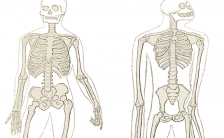Category: Evolution
-

Evolution: Fact, Fiction, or Opinion
This lesson can be used to introduce evolution and establish what your students already understand (or misunderstand) about evolutionary theory. Statements can be printed and cut into slips and students work in small groups to categorize each statement as either Fact, Fiction, or Opinion. The included answer key has quick explanations as well…
-

Comparing the Anatomy of Arthropods (Coloring)
This simple activity was designed for intro level biology (life science). Students read about different types of arthropods and learn what characteristics they share, such as an exoskeleton and segmentation. Then they reading focus on specific groups: insects, arachnids, crustaceans and centipedes. The goal is for them to learn that each group has a…
-

Case Study: How Did the Guppy Get His Color?
This case study examines evolution in guppies as evidenced by color variation in populations. It is based on an iconic study performed by John Endler where he collected data on guppies by scoring the size, number, and brightness of spots. Students progress though the slides (lecture and discussion), and examine details of Endler’s study, such as where…
-

Compare a Human and Chimpanzee Skeleton
This handout can be used in discussions on the evolution of bipedalism or in any unit on the skeletal system. Students label the bones of the skeleton and make comparisons between the forelimbs, hind limbs, and pelvis. I created this handout to compliment an evolutionary lesson and video from HHMI on the “Origin of Humans”…
-

Case Study – Lice and Human Evolution
Google slides present a case of human evolution and the evolution of body lice. Students read details and data and answer questions in small groups.
-

Evolution and the Rock Pocket Mouse (HHMI)
This activity was modified from the HHMI Activity on color variation in the rock pocket mouse which illustrates evolutionary concepts such as fitness, natural selection, and mutation.
-

Case Study: How Do Bacteria Become Resistant?
Students analyze data regarding methicillin and penicillin resistant bacteria, focusing how hospitals inadvertently drive the evolution of resistant strains. Each section of the case explores an aspect of dealing with bacteria, including sanitation, analyzing agar plates uses the Kirby-Bauer disk method and concludes with students suggesting plans for reducing the incidence of MRSA in hospitals. With…
-

Investigation: What Factors Influence Evolution
Explore the relationship between mutation, selection strength and the rate of evolution by using a simulation, which shows how a population evolves.
-

Stickleback Fish – An Evolution Story
Students to examine two lakes and compare the types of fish in each. They learn how lakes form, and why spines may be an advantage for some populations.
-

Cladogram Analysis
A short explanation of phylogeny and using cladograms, where students analyze a diagram, identify derived characters, and then construct their own cladogram.
-

Case Study – Evolution and White Striped Clovers
The production of cyanide by clovers with white stripes is an evolutionary advantage is some environments, but not others.
-

Examining the Fossil Record
During a unit on evolution, students learn a little about geologic time and how we use the fossil record to establish lineages. In this project, students cut out pictures of fictional fossils and arrange them on a chart to show how one species become two species. The activity includes a description of phyletic and…
-

Hardy Weinberg and the Pocket Mouse
Use Hardy Weinberg equilibrium to analyze data of rock pocket mouse populations in the desert.
-

How to Explain Taxonomy to Basic Biology Students
Tips for teaching taxonomy to your biology class. Includes links to student activities.

